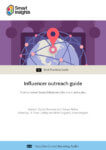The field of Influencer Marketing has grown by a whopping 198% in 2017!
‘Influencer’ seems to be a recurrent buzzword in brand marketing, to raise brand awareness and increase engagement with specific segments of the user base. Many companies, albeit SMEs or large corporations, have become increasingly interested in utilising both micro and macro influencers, to establish effective influencer relations and in turn, run successful brand engagement campaigns for their audiences.
As Adweek states, influencer marketing has expanded exponentially over the past two years, where the industry has gone from being just a rising marketing tactic to an essential part of most marketing budgets in 2018. In fact, according to State of Influencer Marketing Report 2018 by klear, Influencer Marketing, as a field, grew by a whopping 198% in 2017!
Increased budget allocations
According to another report on Influencer Marketing by Linqia, 92% of marketers who used influencer marketing in 2017 found it to be highly effective. As the industry continues to mature, marketers are seizing more and more opportunities to impact the lower funnel metrics in 2018, by using integrated influencer marketing strategies. In fact, research from that report also shows that 39% of B2C marketers are expecting their influencer budgets to increase in 2018.

Shift in ownership, as a medium
With its increase in popularity, influencer marketing has also seen a shift in ownership, as a medium, within the past couple of years. Influencer marketing has traditionally been seen as marketing communications/PR technique, predominantly used to increase reach and awareness. however, as the avenue matures as a marketing platform, it is now increasingly considered to be a part of advertising and media.
A survey conducted in Linqia's report found out that 38% of influencer marketing owners are on advertising/media teams and only 15% are with PR/communications, which was a significant decrease from 31% last year. Influencer marketing is largely starting to fall under the title of media campaigns, as the budget and rigor in the process continues to grow in the same way as other digital advertising channels.

Influencer Outreach Guide
Engaging influencers is now a key marketing tactic to expand your reach and awareness through integrating with your content marketing, social media and SEO activities.This practical guide shows you how to use tools to find and interact with influencers on the best social media platforms for outreach, that’s Twitter, LinkedIn, Facebook and more.
Access the Influencer outreach guide for marketing professionals
Hike in #sponsored content
It’s important to note that influencer marketing is not only starting to be executed as digital advertising by the team members, but it is also starting to be regulated and monitored as such. There have been numerous public instances of influencers dodging regulations and monitoring best practices/regulating this area of marketing has been an ongoing issue for the regulatory bodies. Research at klear found out that there were 1,504,383 posts on Instagram, tagged with #ad in 2017.

On September 2017, the Federal Trade Commission (FTC), in US, released strict guidelines for marketers and influencers, forging relationships, to clearly disclose their connections to the brands they promote or endorse, through practises such as #ad.
However, is this enough? The FTC have a list of regulations and practises they want brand marketers to follow, when undertaking influencer marketing. Take a look our recently updated section on 'Influencer Marketing Regulations', part of our Influencer Outreach guide, to find out more on how influencer relationships are monitored and regulated.










